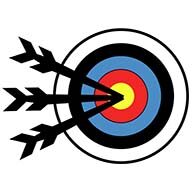Different sports have different risks. You might wonder whether archery is a risky sport. You might think about the historical uses of archery and hunting. In those scenarios archery is used to kill animals or humans, therefore archery must be dangerous right? In this article, I will discuss how dangerous archery really is. I will also discuss what the archery community does to keep it safe. At the end of this article, I will discuss how to keep archery safe if you want to shoot in your backyard.
Archery is a safe sport if you adhere to all safety protocols. Some safety precautions are: using a backstop, creating a buffer zone, and wearing an armguard. With these safety protocols, serious injuries are extremely unlikely to happen.
How safe is archery in terms of numbers
According to West Bend, there are 6,800,000 archers in the United States and yearly 4,300 injuries occur that require emergency room care. That may seem like a lot, but if we divide the total number of injuries by the number of archers, we get a percentage of 0,06%. This means that approximately one in 1700 archers require emergency care.
This still might still seem like a lot of injuries but it’s important to note that most of these injuries are from abrasion from the string or arrow. Although these injuries are painful and require immediate care, in general, they don’t leave lasting damage. Most injuries in archery are bruises due to the string hitting the bow arm. This can easily be prevented by using an armguard. Therefore if all archers were using an armguard there would be almost no injuries caused by archery at all.
The difference between archery and firearms/crossbows
You might think, how can archery be this safe, you still fire projectiles at high speed. Archery is in concept safer than firearms and crossbows, because you can’t accidently fire it. If you for example load a crossbow, you first pull the string backwards and load an arrow. As soon as you pull the trigger, the arrow will fire. Therefore if you keep it cocked and loaded, you can accidently fire your arrow if you tap the trigger.
The shot sequence on archery is different. You start by nocking the arrow and placing it on the arrow rest. The second step is to pull the string back and release when ready to fire. You can’t leave a bow loaded and ready to fire. You need to consciously draw the bow back and release to fire.
My experience with safety
I have been practicing archery for the last 5 years and I never saw any serious accident happen. The club I shoot at has more than 160 members, including many minors between the age of 8 and 18. At our club there are very simple safety rules that make it impossible to accidentally get shot. Everyone is expected to wait behind the waiting line 10 feet (3 meters) behind the line where you shoot. Once everybody has put their bow down, we walk to the target to retrieve the arrows. This practice is mandated by World Archery, the international governing body for archery. I have never been to a club where they don’t adhere to these rules.
On the field the rules are the same, we shoot from one line in the same direction and nobody crosses the line when anybody is firing. Since the string shoots forward, the arrow cannot turn 180 degrees in the air and hit other archers.
When archery can be dangerous
If you have read this far, you see that you can’t accidentally hit another archer if you adhere to the safety precautions. Therefore archery isn’t really any more dangerous than any other regular sport, if you follow the rules. In my experience all archery clubs adhere to the same safety rules, but if you are still not sure you can always ask a member.
Safety precautions
In this section I will discuss in more details, which safety precautions should be taken at archery ranges to ensure safety for archers and the surrounding environment.
Firing and retrieving the arrows
At the range, all archers shoot and retrieve the arrows at the same time. When someone finished shooting this person walks behind the waiting line until all archers have shot their arrows. The waiting line should be at least 10 feet (3 meters) behind the shooting line. Once all archers have shot their arrows and put down their bow, the arrows are retrieved. Sometimes multiple archers shoot on the same target. In this situation it’s important to keep proper distance from the archer pulling out the arrows. Since the arrows are stuck, there is some force involved getting them out. Therefore you might get hurt if you stand too close to the person who is pulling out the arrow.
Backdrop
While shooting outdoors, it might be necessary to have a backdrop. If there is something or someone that could be harmed 300 feet behind the target, a large enough backdrop should be used. If it’s more than 300 feet behind the target, it’s very unlikely that an arrow will fly more than 300 feet by accident, therefore this is a safe margin. A backdrop also makes it easier to retrieve arrows. Especially in a grass field, the arrows tend to go far into the ground if they miss the target. Which will result in a lot of missing arrows in the long run.
See the table below for the size of the backdrop. The backdrop should be able to stop the arrows, therefore it could, for example, exist out of a thick piece of wood, or a stone wall. Another way to catch arrows is with a thick piece of fabric. This large sheet of fabric is not taut but loosely hanged to a string. This way it absorbs the energy of the arrows.
| Shooting distance | Minimum size backdrop |
| 9 meters (10 yards) | 2 x 2 meters (6,5 x 6,5 feet) |
| 18 meters (20 yards) | 3 x 3 meters (9,8 x 9,8 feet) |
| 30 meters (27 yards) | 5 x 3 meters (9,8 x 16,4 feet) |
I would not advise starting archers to shoot from more than 27 yards. But if you need a backdrop for experienced archers you can use the same dimensions as for the 27 yards.
Distance
I have already discussed the distance behind the target, but how much distance should you keep on the two sides of the shooting range? In general I would use the following rule of thumb. Clear the area of at least 35 degrees in both directions from the standard shooting line, see figure. For ease of use I converted this rule of thumb to the common archery distances. See the table for the measurements.

| Shooting distance | Minimum buffer on each side |
| 9 meters (10 yards) | 6 meters (20 feet) |
| 18 meters (20 yards) | 12 meters (40 feet) |
| 30 meters (27 yards) | 21 meters (69 feet) |
If this is however not possible you could use archery nets to shield one or both sides.
Storage
If you store the bow out of sight, it should be behind a locked door to prevent minors from firing unattended. Children do not always consider their actions and can therefore act unpredictably when unattended. My point is strengthened by the following story on the website of West Bend:
‘’ A young boy was shot in the eye during target practice at an archery range. He and a friend were unsupervised and taking turns shooting at a target, but it was windy so the target kept falling over. One of the boys went to hold the target while his friend took his turn to shoot at it. His friend missed the target and the arrow struck him directly in the eye. Luckily, the arrow did not penetrate any further into his skull, but the young boy did lose his eye.’’
This situation could have been prevented if the bows were stored securely. If this isn’t possible, the arrows should at least be stored at a different location which is out of reach for minors.
Clothes
If you are shooting it’s important that you don’t wear anything that could get tangled in the string. Scarfs, earrings, and necklaces for example can be very dangerous if they get tangled in the string. Very loose clothing can also interact with the string, this isn’t dangerous in most cases but can damage your clothing or affect your accuracy. When I was shooting in my backyard, for example, I wore a hoodie with strings in the front on either side. One of the strings got caught in the bowstring, resulting in minor damage to the hoodie. Therefore it’s really important to consider all your clothing and jewelry before shooting. I discuss what you can and can’t wear in more detail in this article:
What to wear while practicing archery – how to keep it safe
How to keep archery safe in your backyard
Sometimes you just want to practice and work on your technique without having to go to the archery range. If you want to shoot in your backyard you should still adhere to all the safety precautions, in order to keep it safe. Some tips from my personal experience:
- Check your local law: where I live you can freely shoot in your backyard as long as you keep it safe. You should however check the regulation for your own area to find out whether this is allowed.
- Don’t use a hard backstop: if you use a hard backstop, a wall for example, the arrows might ricochet back to you. Instead use something soft like: a foam backing, hay bale or archery net.
- Be wary of pets: if you have a pet, make sure that they can’t access the area you are shooting in.
Final thoughts
If you have any questions, you can always leave a comment. I will get back to you as soon as possible. If you are an experienced archer, please leave your feedback and tips!
Tim van Rooijen
For as long as I can remember, I have always been fascinated by archery. First due to its historic significance but later because I like being outdoors. With this blog, I share my knowledge about Archery and how you can improve your shot. More about author…


